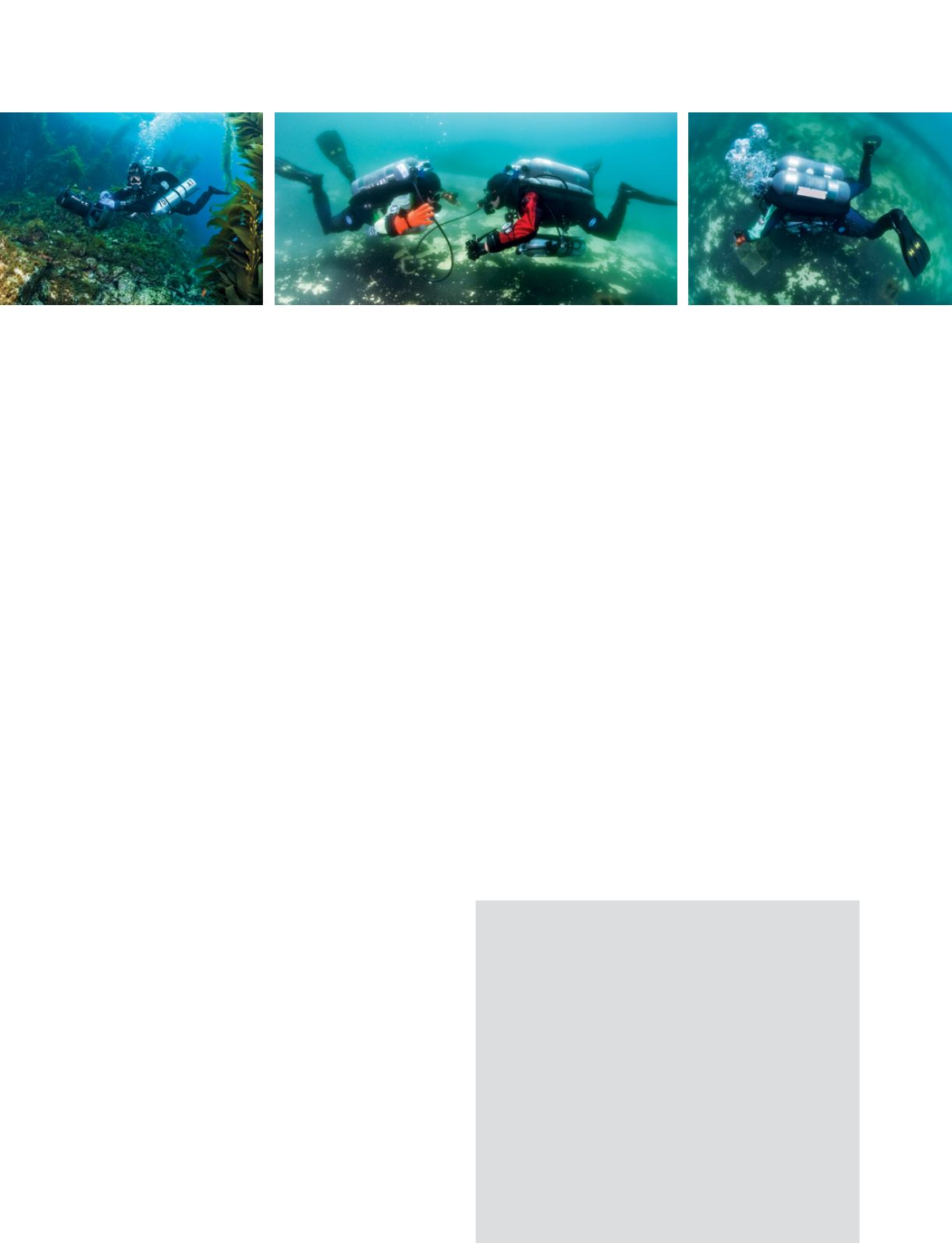
Typically the first step in training is making sure you have
the right equipment and that it’s adjusted properly. Some
divers find that traditional jacket-style BCDs tend to lift the
upper part of the body, making it more difficult to maintain
a horizontal position. For that reason, divers who desire a
more horizontal attitude may prefer a back-mounted BCD
or wings.
Maintaining proper trim is also more difficult if you rely
solely on a conventional weight belt. The best approach
is to distribute weight around your torso. This can be
accomplished by using a stainless-steel back plate, a steel
tank and/or keel or tail weights.
Finally, it’s important not to be overweighted, which
necessitates putting more gas into the BCD, which increases
drag and, thus, the energy required for swimming. Weight
yourself so you are able to hold your position in 10 feet of
water when your tank is nearly empty.
Basic Propulsion Techniques
The following propulsion techniques can improve your trim,
stability and buoyancy control.
Frog Kick:
The frog kick is the kick used when swimming
the breaststroke. The legs mirror each other. This kick is
powerful enough to be used in strong currents, and it’s
relatively easy on the leg muscles, so it can be maintained
for extended periods.
Flutter Kick:
In contrast to the open-water flutter kick,
the bent-leg flutter uses only the lower half of the legs for
propulsion. Keeping the knees bent, the diver kicks and
recovers one leg and then the other in rapid succession,
initiating movement from the knee joint. The movement
is completed by the ankles, which whip the water back and
up with each cycle. The hips and thighs stay motionless
throughout and should not dip below the horizontal plane of
the body.
Back Kick:
The back kick is extremely useful for adjusting
and maintaining your position relative to your dive buddy, the
reef, a wall or a shipwreck. It’s an essential kick for instructors,
cave divers and underwater photographers. The kick applies
the same concept as the frog kick but in reverse. It’s a
challenging but worthwhile kick to learn.
Helicopter Turn:
The helicopter turn enables divers to
turn completely around without breaking horizontal trim
or flapping their arms. As a result, the turn minimizes the
movement of gas in your BCD or drysuit and therefore helps
maintain stability. The movement is essentially a combination
of the back kick and the frog kick. One foot completes one of
the movements before the other foot starts the other one, and
the diver pivots around a vertical axis without dropping the
lower back or the knees.
Practice Is Key
Once you’ve completed your course, you’ll need to practice
your new buoyancy and trim skills until muscle memory
is established. This may take dozens of hours. Consider
practicing in a pool as well as during your dives. Progressive
practice is an effective approach. Start by floating motionless
at your target depth and then add skills such as mask clearing,
valve shut-off drills or gas sharing while remaining neutrally
buoyant and holding a trim position. Practice making three-
minute stops at 10-foot intervals while descending and
ascending. And practice your kicks. By building your skill level
progressively, you’ll have a solid diving platform and, with it,
greater confidence and control — and more fun.
AD
46
|
FALL 2013
RESEARCH, EDUCATION & MEDICINE
//
A D V A N C E D D I V I N G
British Sub-Aqua Club:
Buoyancy and Trim Workshop
Global Underwater Explorers:
GUE Fundamentals
International Association of Nitrox and Technical Divers:
Essentials
National Association of Underwater Instructors:
Introduction to
Technical Diving
Professional Association of Diving Instructors:
Peak Performance
Buoyancy
Scuba Schools International:
Perfect Buoyancy
Technical Diving International:
Intro to Tech Diving
Unified Team Diving:
Extreme Scuba Makeover
Buoyancy and Trim
Training Courses
Good trim makes for a solid platform from which divers can manage
bulky equipment with ease, share air with a buddy or maneuver
efficiently using only their fins.
PHOTOS THIS PAGE: TOM BOYD


